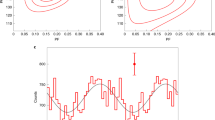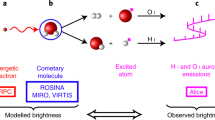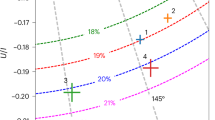Abstract
Strong interplanetary scintillations (IPS) were recorded at 103 MHz at Thaltej (23°02′N, 72°36′E) between 18 and 20 December 1985, when the quasar PKS2314 + 03 was occulted by the ion tail of comet Halley. The scintillation periodicities were near 1 s and their amplitudes decreased progressively as the source approached the end of the tail. The scintillating flux density on these days was 18.2, 11.4 and 4.7 Jy when the source was ∼86° from the Sun. The r.m.s. density variations were 10, 6 and 3 electrons cm−3 on 18,19 and 20 December respectively, and varied with distance r from cometary nucleus as r−3.3. Assuming an ion velocity of 100 km s−1, we show here that the observed periodicity of 1 s implies ion density inhomogeneities of the order of 100 km.
This is a preview of subscription content, access via your institution
Access options
Subscribe to this journal
Receive 51 print issues and online access
$199.00 per year
only $3.90 per issue
Buy this article
- Purchase on Springer Link
- Instant access to full article PDF
Prices may be subject to local taxes which are calculated during checkout
Similar content being viewed by others
References
Brandt, J. C. Introduction to Solar Wind (Freeman, San Francisco, 1970).
Jockers, K. & Lust, R. Astr. Astrophys. 26, 113–121 (1973).
Ip, W.-H. & Axford, W. I. Comets (ed. Wilkening, L. L.) 588–636 (University of Arizona Press, 1982).
Hewish, A. & Symonds, M. D. Planet. Space Sci. 17, 313–320 (1969).
Whitfield, G. R. & Hogbom, J. Nature 180, 602 (1957).
Ananthakrishnan, S., Bhandari, S. M. & Pramesh Rao, A. Astrophys. Space Sci. 37, 275–283 (1975).
Alurkar, S. K. et al. J. Inst. Electron. Telecommun. Engrs 28, 577–582 (1982).
Duffett-Smith, P. J., Mon. Not. R. astr. Soc. 177, 349–355 (1976).
Readhead, A. C. S. & Hewish, A. Mem. R. astr. Soc. 78, 1–49 (1974).
Duffett-Smith, P. J., thesis, Cambridge Univ. (1976).
Scott, S. L. thesis, Univ. California, San Diego (1978).
Preliminary Report and Forecast of Solar Geophysical Data (Joint NOAA-USAF Space Environment Services Center, 1985).
Hewish, A., Tappin. S. J. & Gapper, G. R. Nature 314, 137–140 (1985).
Little, L. T. Meth. Exptl Phys. 12c, 118–137 (1976).
Jockers, K. Proc. ESO Workshop,Paris(1982).
Ershkovich, A. I. Space Sci. Rev. 25, 3–34 (1980).
Readhead, A. C. S., Kemp, M. C. & Hewish, A. Mon. Not. R. astr. Soc. 185, 207–225 (1978).
Schmidt, H. U. & Wegmann, R. Comets (ed. Wilkening, L. L.) 538–560 (The University of Arizona Press, Tucson, 1982).
Buti, B. Astrophys. J. 252, L43–L47 (1982).
Author information
Authors and Affiliations
Rights and permissions
About this article
Cite this article
Alurkar, S., Bhonsle, R. & Sharma, A. Radio observations of PKS2314 + 03 during occultation by comet Halley. Nature 322, 439–441 (1986). https://doi.org/10.1038/322439a0
Received:
Accepted:
Issue Date:
DOI: https://doi.org/10.1038/322439a0
This article is cited by
-
Possible contribution of a solar transient to enhanced scintillation of a quasar
Earth, Moon and Planets (1992)
-
Quasar enhanced
Nature (1989)
-
Occultation observations of compact radio sources through comet Halley's plasma tail
Nature (1987)
-
Scintillation of a radio source observed through the tail of comet Halley
Nature (1987)
Comments
By submitting a comment you agree to abide by our Terms and Community Guidelines. If you find something abusive or that does not comply with our terms or guidelines please flag it as inappropriate.



